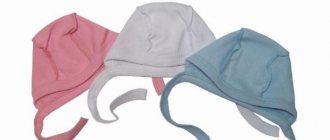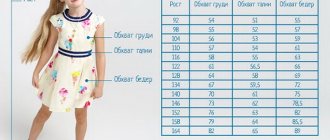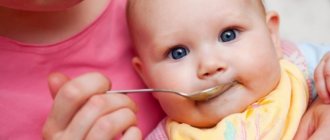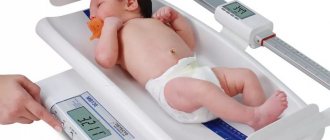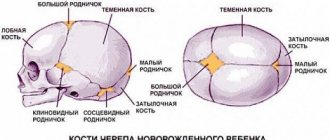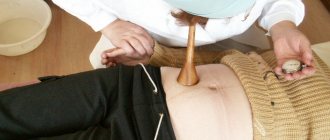November 10, 2016
Averyanova Sveta
The head size of a newborn and a child up to one year is one of the indicators of health. Measurements of the diameter of the skull are carried out without fail at a monthly preventive appointment with a pediatrician. But not every mother understands what these data mean. How to decipher the results of measuring head circumference during a medical examination, compare them with WHO standards, and how to choose a children’s hat based on head circumference is described in detail in our article.
Calculation formulas
You can understand that the girth of a child’s head corresponds to the norm using a simple formula:
- 43 cm – 1.5 cm (for each month of life) for children up to 6 months
- 43 cm + 0.5 cm (for each month of life) after 6 months
Let's give an example. The baby is 4 months old. To calculate the normal head diameter, subtract 1.5 cm from 43 cm four times:
43–1.5–1.5–1.5–1.5–1.5=37 cm
This gives the average diameter. If the length of 35–37 cm is recorded on the measuring tape, then the head circumference corresponds to the norm.
Now let's calculate the average for a child after 6 months, for example, 8 months:
43+0.5+0.5=44 cm
Calculation using the formula is approximate. It is better to get a real result using special tables of correspondence between head circumference and age, gender and other anthropometric data.
Centile table of head circumference sizes by month/year for girls from 0 to 10 years
| Age | Head circumference | |
| cm | % of body length | |
| Up to 1 month | 34 | 68 |
| 1 month | 36 | 68 |
| 2 months | 38 | 68 |
| 3 months | 40 | 68 |
| 6 months | 43 | 65 |
| 9 months | 45 | 64 |
| 1 year | 46 | 62 |
| 2 years | 48 | 56 |
| 3 years | 49 | 52 |
| 4 years | 50 | 50 |
| 5 years | 50 | 47 |
| 6 years | 50 | 44 |
| 7 years | 51 | 43 |
| 8 years | 51 | 41 |
| 9 years | 51 | 39 |
| 10 years | 51 | 38 |
Important! Parents should be aware that the tables show average statistical data that was collected based on studies of groups of children of different ages. Every 10th child has, to one degree or another, small deviations from the norm in head size and the head circumference indicators described above, which are of an individual (hereditary) nature.
Deviations from the norm
Serious deviations from normal values may indicate existing pathologies. Let us give an example of several pathological changes in the shape and diameter of the head that are of serious importance.
- -Hydrocephalic syndrome
Otherwise called hydrocephalus or dropsy of the brain. This condition in a child is very easy to notice - the head grows in sharp leaps, while his body remains small and thin. The frontoparietal region is enlarged several times and stands out above the rest of the surface of the head. An unnaturally large fontanel is also striking to an unprofessional eye. Hydrocephalus often occurs in children after intrauterine infections.
- – Microcephaly
Microcephaly, or small skull, is a pathology in which the perimeter of the baby’s skull is smaller than it should be normally, which leads to mental retardation and neurological abnormalities. The cause of microcephaly can be many factors, some of which are: rubella suffered by the mother during pregnancy, toxoplasmosis, Zika fever, etc.
Size tables
The head circumference of a child up to 1 year old by month and up to 5 years old is presented in the tables below. Boys and girls develop differently, so girth measurements are divided by gender.
Head circumference for girls: norms and deviations from birth to 1 year
Important! The table can be scrolled left and right:
| Age, months | Very low rate, cm | Low indicator, cm | Below average, cm | Average, cm | Above average, cm | High rate, cm | Very high figure, cm | Average chest circumference, cm |
| At the time of birth | 30,3 | 31,5 | 32,7 | 33,9 | 35,1 | 36,2 | 37,4 | 35 |
| 1 | 33 | 34,2 | 35,4 | 36,5 | 37,7 | 38,9 | 40,1 | 35,9 |
| 2 | 34,6 | 35,8 | 37 | 38,3 | 39,5 | 40,7 | 41,9 | 38,1 |
| 3 | 35,8 | 37,1 | 38,3 | 39,5 | 40,8 | 42 | 43,3 | 40 |
| 4 | 36,8 | 38,1 | 39,3 | 40,6 | 41,8 | 43,1 | 44,4 | 41,8 |
| 5 | 37,6 | 38,9 | 40,2 | 41,5 | 42,7 | 44 | 45,3 | 43,1 |
| 6 | 38,3 | 39,6 | 40,9 | 42,2 | 43,5 | 44,8 | 46,1 | 44,3 |
| 7 | 38,9 | 40,2 | 41,5 | 42,8 | 44,1 | 45,5 | 46,8 | 45,1 |
| 8 | 39,4 | 40,7 | 42 | 43,4 | 44,7 | 46 | 47,4 | 46 |
| 9 | 39,8 | 41,2 | 42,5 | 43,8 | 45,2 | 46,5 | 47,8 | 46,7 |
| 10 | 40,2 | 41,5 | 42,9 | 44,2 | 45,6 | 46,9 | 48,3 | 47 |
| 11 | 40,5 | 41,9 | 43,2 | 44,6 | 45,9 | 47,3 | 48,6 | 47,7 |
| 12 | 40,8 | 42,2 | 43,5 | 44,9 | 46,3 | 47,6 | 49 | 48 |
Head circumference for girls from 1 year to 5 years
Important! The table can be scrolled left and right:
| Age, year | Very low rate, cm | Low indicator, cm | Below average, cm | Average, cm | Above average, cm | High rate, cm | Very high figure, cm | average chest circumference, cm |
| 1 | 40,8 | 42,2 | 43,5 | 44,9 | 46,3 | 47,6 | 49 | 48,3 |
| 2 | 43 | 44,4 | 45,8 | 47,2 | 48,6 | 50 | 51,4 | 50,2 |
| 3 | 44,3 | 45,7 | 47,1 | 48,5 | 49,9 | 51,3 | 52,7 | 51,8 |
| 4 | 45,1 | 46,5 | 47,9 | 49,3 | 50,8 | 52,2 | 53,6 | 53,2 |
| 5 | 45,7 | 47,1 | 48,5 | 49,9 | 51,3 | 52,8 | 54,2 | 54,8 |
Head circumference for boys: from birth to 12 months
Important! The table can be scrolled left and right:
| Age, months | Very low rate, cm | Low indicator, cm | Below average, cm | Average, cm | Above average, cm | High rate, cm | Very high figure, cm | Average chest circumference, cm |
| Moment of birth | 30,7 | 31,9 | 33,2 | 34,5 | 35,7 | 37 | 38,3 | 34,8 |
| 1 | 33,8 | 34,9 | 36,1 | 37,3 | 38,4 | 39,6 | 40,8 | 36,5 |
| 2 | 35,6 | 36,8 | 38 | 39,1 | 40,3 | 41,5 | 42,6 | 38,3 |
| 3 | 37 | 38,1 | 39,3 | 40,5 | 41,7 | 42,9 | 44,1 | 38,4 |
| 4 | 38 | 39,2 | 40,4 | 41,6 | 42,8 | 44 | 45,2 | 41,4 |
| 5 | 38,9 | 40,1 | 41,4 | 42,6 | 43,8 | 45 | 46,2 | 42,9 |
| 6 | 39,7 | 40,9 | 42,1 | 43,3 | 44,6 | 45,8 | 47 | 44,3 |
| 7 | 40,3 | 41,5 | 42,7 | 44 | 45,2 | 46,4 | 47,7 | 45,5 |
| 8 | 40,8 | 42 | 43,3 | 44,5 | 45,8 | 47 | 48,3 | 46,4 |
| 9 | 41,2 | 42,5 | 43,7 | 45 | 46,3 | 47,5 | 48,8 | 47,2 |
| 10 | 41,6 | 42,9 | 44,1 | 45,4 | 46,7 | 47,9 | 49,2 | 47,9 |
| 11 | 41,9 | 43,2 | 44,5 | 45,8 | 47 | 48,3 | 49,6 | 48,4 |
| 12 | 42,2 | 43,5 | 44,8 | 46,1 | 47,4 | 48,6 | 49,9 | 48,7 |
Head circumference for boys from 1 year to 5 years
Important! The table can be scrolled left and right:
| Age, year | Very low rate, cm | Low indicator, cm | Below average, cm | Average, cm | Above average, cm | High rate, cm | Very high figure, cm | average chest circumference, cm |
| 1 | 42,2 | 43,5 | 44,8 | 46,1 | 47,4 | 48,6 | 49,9 | 48,7 |
| 2 | 44,2 | 45,5 | 46,9 | 48,3 | 49,6 | 51 | 52,3 | 51,4 |
| 3 | 45,2 | 46,6 | 48 | 49,5 | 50,9 | 52,3 | 53,1 | 52,8 |
| 4 | 45,8 | 47,3 | 48,7 | 50,2 | 51,7 | 53,1 | 53,7 | 53,8 |
| 5 | 46,3 | 47,7 | 49,2 | 50,7 | 52,2 | 53,7 | 55,2 | 55,6 |
It is possible to correlate head circumference measurements and norms using tables only for children born at term.
So, for example, if a baby was born prematurely with a weight of 1.0-1.5 kg, then for him at 2-3 months the normal figure will be 342 mm. Although for full-term infants, such a head size even at one month of age is a low indicator.
For premature babies, there are other norms, formulas and schemes based on the baby’s weight, birth date and other individual indicators.
Centile table of head circumference sizes by month/year for boys from 0 to 10 years
| Age | Head circumference | |
| cm | % of body length | |
| Up to 1 month | 35 | 69 |
| 1 month | 37 | 69 |
| 2 months | 39 | 68 |
| 3 months | 41 | 67 |
| 6 months | 44 | 65 |
| 9 months | 46 | 64 |
| 1 year | 47 | 63 |
| 2 years | 49 | 57 |
| 3 years | 50 | 52 |
| 4 years | 51 | 50 |
| 5 years | 51 | 47 |
| 6 years | 51 | 45 |
| 7 years | 52 | 43 |
| 8 years | 52 | 41 |
| 9 years | 52 | 40 |
| 10 years | 52 | 38 |
Deviations from norms
It is impossible to diagnose a disease based on a single indicator that deviates from the generally accepted ones. If the baby has a large or small head, then the pediatrician and neurologist are required to pay attention not only to the size of the head, but also to the measurements of chest circumference, weight, pelvic volume, and build. It is useful to look at the parents' children's medical records. Perhaps the deviations are inherited.
Parents and doctors should be alarmed in the following situations:
- The baby's skull is too large, veins protrude on the head, the fontanelles are large and convex, the forehead is large and protrudes strongly forward. In this case, the baby may have hydrocephalus. The exact diagnosis needs to be determined after ultrasound, measurements of fluid in the brain, based on MRI data.
- The skull is small and underdeveloped. Simultaneously with the minimum head circumference, the baby exhibits neurological disorders, the forehead is low and small, and the fontanelles have closed prematurely. In this case, the pediatrician suspects microcephaly.
Moms should know! It is important that the head circumference of a one-year-old child does not exceed the chest measurement data.
They approach each other at three to four years of age. If a serious discrepancy is found, you should immediately consult a doctor.
Why is head circumference measured in the first year of life?
Good nutrition and parental care for the child’s health helps him grow up as an active member of society. To maintain health, your baby needs quality care. The basic norms that reflect the development of a baby include his weight, height, psychomotor development and head circumference.
When assessing the physical, mental and emotional state of a small child, attention is first paid to the size of his head. Together with the parents, from the very birth of the baby, the local pediatrician monitors his development and growth. Its correct structure and uniform development indicate that the child is developing normally.
There are standards according to which the head circumference should change; the size should be the same as in the table, or should be as close to it as possible. These indicators must be treated very carefully. If a significant deviation from the norm is observed when measuring the head, you need to sound the alarm and conduct an examination of the baby to identify deviations.
In the first year of life, head volume is measured every month. Particularly attentive to the development of the skull of babies who received injuries during childbirth or were born premature.
How to measure correctly
Children under one year of age should have their head circumference measured regularly: once a month. Take measurements correctly like this:
- Take a measuring tape (tailor's tape).
- They place the newborn toddler on the table or put the 6-month-old baby on a high chair.
- To correctly measure the girth, place the tape on the back of the head so that it passes over the ears, through the occipital protuberance.
- Connect the starting point of the tape (0 cm) and the end point above the eyebrow arches.
- Compare the obtained data with the norms.
For greater clarity, we recommend that you watch this short video:
To obtain the correct result for comparing it with the norms, use the following recommendations:
- Determine the head diameter using the same tape every month. This way you will eliminate errors.
- Do not put pressure on the baby's head, especially during infancy. An infant's bones are fragile.
- If the baby cries or squirms, try again to measure the girth of the skull a little later.
- Record measurement results without rounding (to the nearest mm).
- Keep a diary where you will enter your baby’s anthropometric data every month.
Important! The child's chest is measured at the level of the nipples and the lower angle of the shoulder blades. During the procedure, the baby must be calm. Deep, intermittent breathing and crying will distort the measurement.
Rules and algorithm for measuring head circumference
Head circumference in children is measured with a measuring tape once a month. The values must be entered into the table in order to clearly see all the changes.
How to measure your head:
- Place the baby on a horizontal surface. A one-year-old child can be sat down or asked to stand upright for a few minutes.
- Wipe the centimeter with an antiseptic or disinfectant solution.
- Place a measuring tape along the frontal and superciliary protuberances in front, stretching to the occipital protuberance.
- The ends of the tape should not move relative to each other.
- The result obtained is the circumference of the child’s skull.
Measurements should be taken when the child is calm and in a good mood. Skull girth higher or lower than normal is not always a sign of pathology. The maximum permissible range of deviations is up to 3-4 cm. There is no need to worry if the child is active, development corresponds to age, there are no signs of increased intracranial pressure, and the fontanelles close on time.
The formula for calculating the circumference of the skull in children aged 0-4 months: 43-(6-A)*1.5. A – baby’s age in months. A two-month-old baby has a normal head size - 43-(6-2)*1.5=37 cm.
Formula for calculating head volume for children 5-12 months. (A-6)*0.5+43. A – child’s age in months. The formula for calculating the skull circumference for children 1-5 years old is (50-5) + A, where A is the number of full years.
How to choose a hat size
It is better to choose a hat together with your child.
This way, not only the width of the elastic band is ideally selected, but also the depth of the cap. If you have to decide without a baby or the cap is bought as a gift, use the age indicators from the table. But it is worth considering their averageness. The algorithm of actions in the store is as follows:
- Pay attention to the headgear size markings. The inscriptions on labels in Russia are very easy to read. The size of the hat corresponds to the diameter of the baby's head. For example, at 2 years the girth is on average 48-49 cm, and at a year - 46-47 cm. This means that for a 2-year-old baby you need to buy a size 48 cap, and for a one-year-old - 46.
- Manufacturers of domestic hats sew hats for children according to a step-by-step size chart, deviating from the previous one by 1 cm. That is, size 35 - head diameter 35 cm, 36 cm, 37 cm and so on. It is almost impossible to make a mistake with the choice of size.
- In rare cases, baby caps are sewn according to the size chart in 2 cm increments. In this case, choose a larger size, especially if the headdress is made of dense, non-stretchy fabric.
- If a knitted or fabric product has a double size: 35–36, then the material stretches well. The cap is suitable for several ages and head sizes.
- It is more difficult to choose hats for winter. You need to carefully approach the height of the forehead and the depth of the headdress. It is better to take such products home to try on or bring your child to the store.
- Lightweight bonnets, scarves, and crocheted spring hats are sold with double markers on the labels separated by fractions. For example, 40/68.
The first number indicates the diameter of the head, the second indicates the height of the child.Base your choice on the individual characteristics of the baby. If the toddler is tall, then look at the first indicator; if he is of average height, then consider both.
- You should not believe labels that indicate only the child’s age (for example, 1 year or 6 years). Babies can grow according to an individual plan and are born with heads of different sizes. In six months or a year, the volume ratios can vary by up to 4 cm.
Note to grandmothers and home craftswomen! It is imperative to knit a hat for children according to a recently taken measurement. Get the latest information from your parents. If sewing a handmade gift will take more than a month, feel free to add another 2-3 cm to the length and width.
What are the differences between the head sizes of girls and boys?
Head circumference in children varies by gender; boys are much larger from birth than girls. And their head volume is a whole centimeter larger. In addition, we should not forget that up to a certain age, boys are ahead of girls in their physical development and grow a little faster.
See also: Three prohibited actions when a child has hiccups. Causes of hiccups and preventive measures
Later, the kids level out, and then the girls are ahead of the boys in height. And only in adolescence do boys physically catch up with girls again. All this affects the indicators of measuring the weight and height of children.
Table of head circumference sizes by month
What to do if foreign marking is indicated
Foreign manufacturers rely on their own measurements when printing labels on caps. To understand them correctly, to buy a cap or headband that fits, or to ensure that the hat does not turn out to be small or large, you need to convert the sizes of hats from America and Europe to Russian. Use the table (Important! It can be scrolled left and right):
| Manufacturer/Child's head diameter | USA | France | England | Marking in Latin letters |
| 47 | 5 7/8 | 0 | 5 | — |
| 49 | 6 1/8 | 1 | 6 | S/M |
| 51 | 6 | 2 | 6 1/4 | XXS |
| 53 | 6 5/8 | 3 | 6 1/2 | XS |
| 55 | 7 | 4 | 6 3/4 | S |
| 57 | 8 | 5 | 7 | M |
With increasing interest in clothing and hats from Western manufacturers, the number of double-labeled hats among Russians is increasing. Foreign marketers write on labels the sizes for buyers in Western countries, Europe and the Russian version, that is, the diameter of the child’s head in cm. It is necessary to use the comparison table less often.
Changing the shape of the skull
During pregnancy, a woman should adhere to a healthy diet and give up bad habits, as this affects the shape of the newborn's head. Mothers who smoke give birth to babies with small skull sizes - nicotine does not allow oxygen to enter the placenta, and the brain does not develop.
All this can lead to microcephaly - a decrease in the volume of the head and early closure of the fontanelles (about 29 cm). The disease changes the appearance of the child and has the following symptoms:
- large facial section;
- small forehead;
- sloping line of the forehead and nose.
If a woman has endocrine pathologies, the head, on the contrary, increases in volume (more than 34 cm). If the head is large, doctors prescribe a caesarean section because the baby will not pass through the birth canal.
This is how a baby's head is measured
The skull grows due to an increase in the amount of fluid. Hydrocephalus develops. Its signs:
- small facial region compared to the brain;
- protruding forehead;
- veins on the temples.
Craniostenosis is also possible, a congenital malformation of the cranial bones in which one or more cranial sutures close prematurely. The brain develops normally, but it cannot grow. There is an increase in intracranial pressure. If one seam closes, the skull becomes deformed. In such cases, you need to consult a neurologist and neurosurgeon.
These diseases delay mental and physical development. Identifying them early can minimize the risks.
If your child has abnormalities in the development of the skull, this does not mean that he has a disease.
To identify pathologies, the doctor prescribes an ultrasound of the brain (neurosonography). The procedure is safe and painless. With its help, you can see the structure of the brain and the condition of the blood vessels. If there are diseases, the doctor prescribes treatment.
Causes
- Postpartum - a constant position with emphasis on the bones of the skull (mainly lying on the back) or premature fusion of the sutures of the skull.
- Intrauterine - in most cases caused by the anatomical position during gestation - with twin pregnancies and/or pressing the fetus against the mother's ribs, large fetal size or uterine anomalies, premature prolapse during childbirth.
- Pathological conditions - torticollis, or torticollis - shortening of the neck muscles on one side, other neuromuscular diseases.
Previously, the disease was diagnosed less frequently - due to the fact that pediatricians recommended laying newborns on their side. Today it has been proven that this position increases the risk of sudden infant death syndrome during sleep, therefore, since 1992, children have been recommended to be placed on their back while sleeping, which becomes a common cause of deformation of the skull bones that are not yet fully formed.
How to choose the right hat
When purchasing a headdress for a child, in addition to size, you need to focus on the following criteria:
- Material of manufacture . Winter models should be as warm as possible and protect the child’s ears from the cold wind. The most suitable materials for winter headwear: wool, raincoat fabric, natural fur with fleece or cotton lining. For summer models, linen or cotton is suitable.
- Style . It also plays a role for which season the headdress is chosen. For cold or cool weather, helmets, ear flaps, knitted hats with ties, and fur earmuffs are suitable. For the summer season, Panama hats, bandanas, hats, and caps are suitable options.
Determining the size of a children's headdress is very simple. To do this, you need to take accurate measurements and use them to find the right size in the manufacturer’s sizing chart.
How to determine the size of a children's hat
The easiest way to choose the right hat for your child is to try it on and choose the one that “fits” best. But this option only works in one case: if you buy a hat in a store, or, say, at the market.
Those who have tried online shopping at least once in their life know how unprofitable offline shopping is. A hat, cap or bonnet produced by a well-known brand, carefully tailored and made of high-quality materials, when purchased in a regular store, will cost you 3-4 times more than the same thing bought on ebay or, for example, in the online stock 6PM.
In order not to waste money, it makes sense to buy a hat, like other items of clothing, online. But how to choose the right size for a children's hat? That's how.
Traditionally, hat size is the circumference of the head, measured in centimeters.
Take a soft tailor's ribbon and wrap it around the child's head - approximately along the line along which the bottom border of the hat will "sit": above the eyebrows, over the ears (or behind them - depending on whether the headdress should cover them) and at the most convex part of the back of the head. Do not pull the flexible “centimeter”, it should lie freely!
The measured value is the size of the children's hat you need.
In the absence of a measuring tape, you can use a regular lace, which you then simply need to attach to any ruler.
